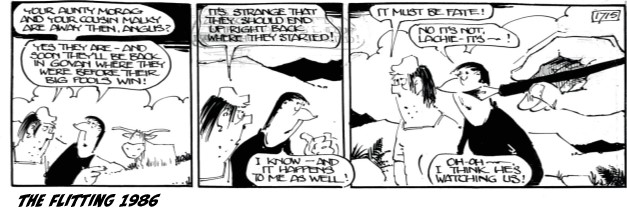Is obair latha tòiseachadh: Beginning is a day’s work’
‘There’s a Gaelic proverb that says it’s a day’s work starting, and I find that true’ says Bain. ‘Once I get into it, it all goes smoothly. I don’t worry about running dry. I suppose I have quite a lot of confidence in myself. I’m not trying to put any kind of message across. Sometimes I put political comments in, but they spring from the story. I draw for a living because I can do it. It’s better than working.’ – Ewen Bain.

The Angus Og cartoons appeared in the daily record every weekday from 1960 – 1989. Each cartoon works as a humorous mini story whether you have read the strip before or not. However, from the outset the cartoons were intended to form a series and Ewen Bain’s storytelling genius lies in the way in which he combines these strips into an overarching story. In the early days editors asked for an outline of each story but Bain worked best with artistic freedom to allow the story to develop as it unfolded. In 1982 Bain was asked ‘after 22 years of Angus Og, are you finding it more or less difficult to come up with entertaining situations?’ he replied that ‘it’s no more difficult – nor any easier- than it was 20 years ago.
We know from his Og Logs – working notebooks- that each story was detailed in bullet points on the right-hand page accompanied by draft drawings of characters or equipment featured in the story. We can see in the Og Logs ideas developing as stories were planned, character’s names changed, and prototypes developed.

From the Og Logs each cartoon began to take shape. Ewen Bain marked out frames in pencil and drew lines to ensure the text appeared in straight lines. Editing continued throughout as the drawing process and once satisfied with the layout Ewen would draw in the detail with pen and ink.
From the Og Logs each cartoon began to take shape. Ewen Bain marked out frames in pencil and drew lines to ensure the text appeared in straight lines. Editing continued throughout as the drawing process and once satisfied with the layout Ewen would draw in the detail with pen and ink.
In 1971 the daily record became the first European newspaper to be printed in ‘full colour’. Ewen Bain developed an innovative technique of colour overlays to provide the print room with a guide to the finished colour featured in each cartoon. editing continued even after the strips had been submitted to the paper with notes from the editor in the margins of cartoons and occasionally sections of text literally cut out and new text pasted on top where it was felt that the original text may have been a bit too risky!

Bain, on being asked what benefits he got from an art school education, replied ‘art school training, though by no means essential for a cartoonist, is bound to improve one’s draughtsmanship, powers of observation, etc.’ the Angus Og cartoons are beautifully drawn with a sense of depth and perspective not often seen in newspaper cartoons. for all Bain was a serious artist his sense of fun shines through. he plays with frame boundaries and illustrated onomatopoeia, adds humorous detail in the background of images and enjoys breaking the third and fourth walls.
Drambeg existed vividly and in colour in Bain’s mind even as it was drawn and printed in black and white. The cartoon was an important part of cultural life in Scotland throughout the latter part of the 20th century. Do you remember Angus Og? Share your memories with us here.

